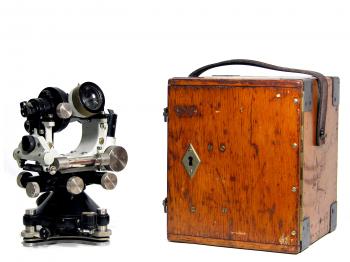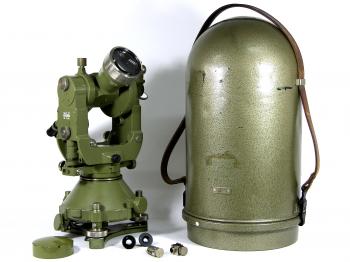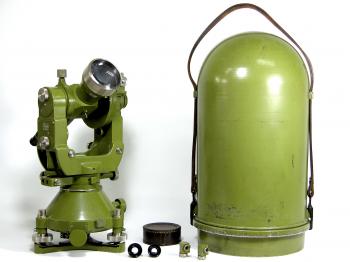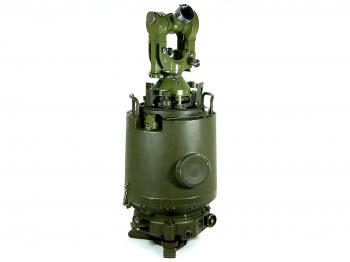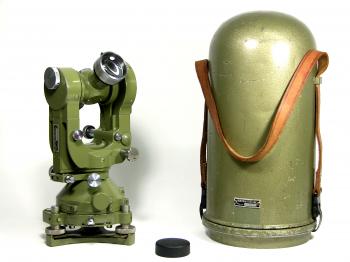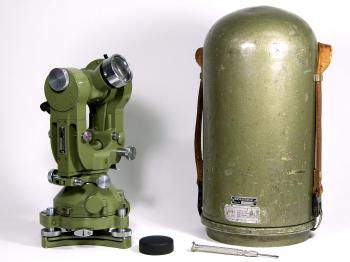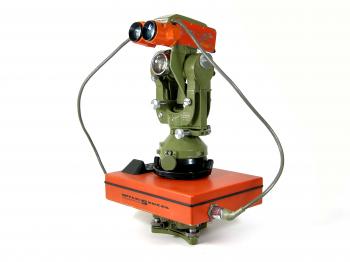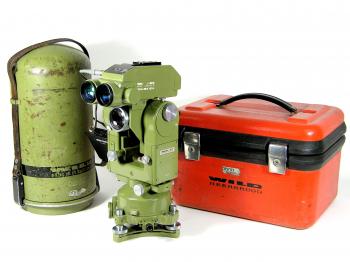TheodolitesThe theodolites in my collection show the mayor change in the development of the theodolite at the start of the 20th century which took place thanks to one brilliant instrument maker: Heinrich Wild. Initially he was consultant for Carl Zeiss where he made and patented several improvements based on ideas he formed in the period he used geodetic instruments himself as a surveyor. The very first of his ideas were applied to levelling instruments like the Carl Zeiss Nivilier II. Soon the first theodolite was produced with his improvements, the Carl Zeiss RThII. A mayor breakthrough was his very first completely re-designed and now fully optical theodolite, the Carl Zeiss ThI. After leaving Carl Zeiss, Heinrich Wild started his own company, initially only producing levels as the Wild N2, but soon followed by his archetype Wild T2. The T2 would become his best-seller theodolite and perhaps the most widely used universal theodolite ever made. It saw various modifications until it reached its final model as the Wild T2 mod. As part of the Autonetics Base Line Equipment (ABLE) it even made its way to the U.S. army. For even more accurate surveys the T2 was followed by the end of the 1920's by the T3 of which models were made for both geodetic and astronomic work. It was not until 1941 that an even more accurate theodolite was created, the T4. Heinrich Wild also left his own firm and continued at Kern Aarau. One of the theodolites he designed there as the competitor to his Wild T2 was the Kern DKM2. The enormous impact of Wild's ideas becomes clear when his early instruments are compared to period instruments of other manufacturers like the Société des Lunetiers theodolite and the Keuffel & Esser transit. Fully enclosed, painted instruments with glass circles and optical reading mechanisms would become the standard which was soon followed up by other instrument makers as Askania with their model Tu 400. Still the American transit inspired Wild to create his fully integrated boussole theodolite, the Wild T0, which was the first boussole instrument with diametric reading of the boussole. Another first was the Wild T1A, a theodolite with an automatic compensator for the vertical circle. It was the successor of the Wild T1. The use of conventional stadia hairs allowed to measure slope distances with these theodolites. Getting those into a chart required calculation of the horizontal distance from them using the slope distance and vertical angle. On the road towards the first electronic theodolites and total stations this issue was overcome by optical distance meters that allowed for automatic horizontal reduction of the slope distance. Examples of these instruments are the 1960s Zeiss BRT 006, the 1952 Wild RDH and 1963 Wild RDS in the collection, but also by adding electronic distance meters (EDMs) on top of existing theodolites like the 1976 Wild Di3S / 1963 T2 and the 1990 Wild T2 mod - Di1000 combinations. If you have any questions and/or remarks please let me know. |
Surveyor's crosses... Geodetic Sextants... Theodolites... Total Stations... Levels... Standards... Tools... Firms...
19th c. SDL 1919 K&E 1926 Zeiss RThII 1924 Zeiss Th1 1929 Wild T2 1937 Wild T3 (astronomic) 1939 Wild T3 (geodetic) 1943 CT&S Tavistock 1948 Wild T1 1950s Askania Tu400 1952 Wild RDH 1956 Wild T0 1960s Zeiss BRT 006 1961 Wild T1A 1961 Wild MIL-ABLE T2 1962 Wild T2 1963 Wild RDS 1966 Kern DKM2 1969 Wild T2E 1969 Wild Di10 / 1972 T2 1976 Wild Di3S / 1963 T2 1976/79 Wild T2 mod - DI4 1990 Wild T2 mod - Di1000




